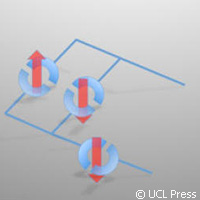Home > Press > Superconductors and X-ray beams: the drawing shapes
 |
Abstract:
An Italian-British team of scientists has succeeded in drawing superconducting shapes using an X-ray beam. Presented in the journal Nature Materials, the study shows how being able to create and control tiny superconducting structures could lead to innovative electronic devices. The research was funded in part by COMEPHS ('Controlling mesoscopic phase separation'), a project supported by the EU. COMEPHUS was backed under the 'Nanotechnologies and nanosciences, knowledge-based multifunctional materials and new production processes and devices' (NMP) Thematic area of the EU's Sixth Framework Programme (FP6) to the tune of EUR 3.18 million.
Superconductors and X-ray beams: the drawing shapes
Brussels, Belgium | Posted on September 14th, 2011Researchers from the London Centre for Nanotechnology in the United Kingdom and Sapienza University of Rome in Italy have successfully manipulated regions of high temperature superconductivity, in a material that combines oxygen, copper and a heavier element called lanthanum, at the Elettra (Trieste) synchrotron radiation facility. Superconductivity, say experts, is a special state where a material conducts electricity with no resistance. In essence, zero energy is wasted.
According to the researchers, high temperature superconductivity is triggered when oxygen atoms in the material are re-arranged thanks to X-rays being illuminated. This type was first discovered by scientists a quarter of a century ago. Shapes can be drawn in two dimensions when the X-ray beam is used like a pen.
The researchers could also erase structures by applying heat treatments. So not only do the tools allow them to write/draw with high precision, but they can also erase with just a few easy steps and without any chemicals. They say rearranging the underlying structure of a material can be applied to other compounds containing metal atoms and oxygen. Fuel cells and catalysts are an example.
'Our validation of a one-step, chemical-free technique to generate superconductors opens up exciting new possibilities for electronic devices, particularly in re-writing superconducting logic circuits,' says co-author Professor Gabriel Aeppli of the London Centre for Nanotechnology and the Department of Physics and Astronomy, University College London. 'Of profound importance is the key to solving the notorious 'travelling salesman problem', which underlies many of the world's great computational challenges. We want to create computers on demand to solve this problem, with applications from genetics to logistics. A discovery like this means a paradigm shift in computing technology is one step closer.'
Commenting on the results, co-author Professor Antonio Bianconi of Sapienza University in Rome says: 'It is amazing that in a few simple steps, we can now add superconducting 'intelligence' directly to a material consisting mainly of the common elements copper and oxygen.'
####
For more information, please click here
Copyright © European Commission
If you have a comment, please Contact us.Issuers of news releases, not 7th Wave, Inc. or Nanotechnology Now, are solely responsible for the accuracy of the content.
| Related Links |
| Related News Press |
Superconductivity
News and information
![]() Researchers develop molecular qubits that communicate at telecom frequencies October 3rd, 2025
Researchers develop molecular qubits that communicate at telecom frequencies October 3rd, 2025
![]() Next-generation quantum communication October 3rd, 2025
Next-generation quantum communication October 3rd, 2025
![]() "Nanoreactor" cage uses visible light for catalytic and ultra-selective cross-cycloadditions October 3rd, 2025
"Nanoreactor" cage uses visible light for catalytic and ultra-selective cross-cycloadditions October 3rd, 2025
Chip Technology
![]() Lab to industry: InSe wafer-scale breakthrough for future electronics August 8th, 2025
Lab to industry: InSe wafer-scale breakthrough for future electronics August 8th, 2025
![]() A 1960s idea inspires NBI researchers to study hitherto inaccessible quantum states June 6th, 2025
A 1960s idea inspires NBI researchers to study hitherto inaccessible quantum states June 6th, 2025
![]() Programmable electron-induced color router array May 14th, 2025
Programmable electron-induced color router array May 14th, 2025
Discoveries
![]() Researchers develop molecular qubits that communicate at telecom frequencies October 3rd, 2025
Researchers develop molecular qubits that communicate at telecom frequencies October 3rd, 2025
![]() Next-generation quantum communication October 3rd, 2025
Next-generation quantum communication October 3rd, 2025
![]() "Nanoreactor" cage uses visible light for catalytic and ultra-selective cross-cycloadditions October 3rd, 2025
"Nanoreactor" cage uses visible light for catalytic and ultra-selective cross-cycloadditions October 3rd, 2025
Announcements
![]() Rice membrane extracts lithium from brines with greater speed, less waste October 3rd, 2025
Rice membrane extracts lithium from brines with greater speed, less waste October 3rd, 2025
![]() Researchers develop molecular qubits that communicate at telecom frequencies October 3rd, 2025
Researchers develop molecular qubits that communicate at telecom frequencies October 3rd, 2025
![]() Next-generation quantum communication October 3rd, 2025
Next-generation quantum communication October 3rd, 2025
![]() "Nanoreactor" cage uses visible light for catalytic and ultra-selective cross-cycloadditions October 3rd, 2025
"Nanoreactor" cage uses visible light for catalytic and ultra-selective cross-cycloadditions October 3rd, 2025
|
|
||
|
|
||
| The latest news from around the world, FREE | ||
|
|
||
|
|
||
| Premium Products | ||
|
|
||
|
Only the news you want to read!
Learn More |
||
|
|
||
|
Full-service, expert consulting
Learn More |
||
|
|
||








